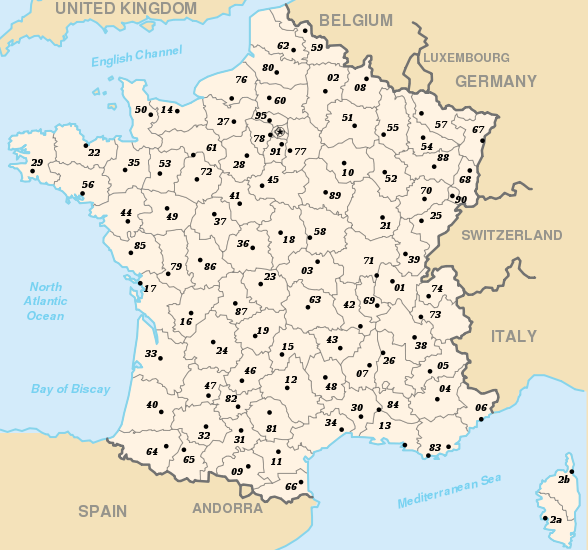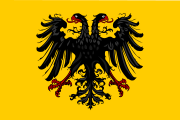Departments of France
 |
|
This article is part of the series on
Administrative divisions of France |
|
(incl. overseas regions) |
|
Departments
(incl. overseas departments) |
|
Urban communities |
|
Associated communes |
|
Others in Overseas France
Overseas collectivities |
In the context of the political and geographic organization of France and many of its former colonies, a department (French: département, pronounced [depaʁtǝmɑ̃]) is an administrative division roughly analogous to an English or United States county or a Scottish region. The 100 French departments are now grouped into 22 metropolitan and four overseas regions. All regions have identical legal status as integral parts of France. They are subdivided into 342 arrondissements.
Contents |
General characteristics
In continental France (metropolitan France, excluding Corsica), the median land area of a department is 5,965 km² (2,303 square miles), which is two-and-a-half times the median land area of a ceremonial county of England, and slightly more than three-and-half times the median land area of a county in the United States.
At the 2001 census, the median population of a department in continental France was 511,012 inhabitants, which is 21 times the median population of a U.S. county, but less than two-thirds of the median population of a ceremonial county of England.
The chef-lieu de département, department capital or seat of government, normally lies at the geographical centre of the département. This was determined according to the time taken to travel on horseback from the periphery of the département. The goal was for the chef-lieu to be accessible by horseback from any town in the département within 24 hours.
Administrative role
Each département is administered by a conseil général (general council), an assembly elected for six years by universal suffrage, and its executive. Since 1982, the executive is the president of that council (formerly it was headed by the prefect).
The French national government is represented in the département by a préfect (prefect) appointed by the national executive (the President or the Prime Minister). The prefect is assisted by one or more sub-prefects based in district centres outside the capital of the département.
The center of administration of a département is called a préfecture (prefecture) or chef-lieu de département. Départements are divided into one to seven arrondissements. The capital city of an arrondissement is called the sous-préfecture (subprefecture) or chef-lieu d'arrondissement. The public official in charge is called the sous-préfet (sub-prefect).
The départements are further divided into communes, governed by municipal councils. France (as of 1999) has 36,779 communes.
Most of the départements have an area of between 4,000 and 8,000 km², and a population between 250,000 and one million. The largest in area is Gironde (10,000 km²), while the smallest is the city of Paris (105 km²). The most populous is Nord (2,550,000) and the least populous Lozère (74,000). See also: List of French departments by population
The départements are numbered: their two-digit numbers appear in postal codes, in INSEE codes (including "social security numbers") and on vehicle number-plates. In January 2009 a new number-plate scheme will succeed the latter application (for details see French vehicle registration plates). Initially, the numbers corresponded to the alphabetical order of the names of the départements, but several changed their names, so the correspondence became less exact.
There is no number 20, but 2A and 2B instead, for Corsica. Corsican postal codes or addresses in both departments do still start with 20, though. The two-digit code "98" is used by Monaco. Together with the ISO 3166-1 alpha-2 country code FR, the numbers form the ISO 3166-2 country subdivision codes for the metropolitan départements. The overseas départements get two letters for the ISO 3166-2 code, e.g. 971 for Guadeloupe (see table below).
History


Departments were created on 4 March 1790 by the Constituent Assembly to replace the country's former provinces with a more rational structure. They were also designed to deliberately break up France's historical regions in an attempt to erase cultural differences and build a more homogeneous nation. Most departments were named after an area's principal river(s) or other physical features.
The number of departments, initially 83, was increased to 130 by 1810 with the territorial gains of the Republic and of the Empire (see Provinces of the Netherlands for the annexed Dutch departments). Following Napoleon's defeats in 1814-1815, the number of departments was reduced to 86. The Congress of Vienna returned France to its pre-war size; the total was 86, as three of the original departments had been split. In 1860, France acquired the Comté de Nice and Savoy, which led to the creation of three new departments. Two were added from the new Savoyard territory, while the department of Alpes-Maritimes was created from Nice and a portion of the Var department. The 89 departments were given numbers based on their alphabetical order.
Three departments in Alsace-Lorraine (Haut-Rhin, Bas-Rhin, and Moselle) were ceded to the German Empire in 1871, following France's defeat in the Franco-Prussian War. A small part of the department of Haut-Rhin, called the Territoire de Belfort, was detached from the rest of Alsace-Lorraine and remained French.
In 1919, following World War I, France regained Alsace-Lorraine. Territoire de Belfort was not reintegrated into Haut-Rhin, but was instead made a full-status department in 1922, becoming the 90th department of France.
Reorganisations of the Paris region (1968) and the division of Corsica (1975) added six more departments, raising the total to one hundred. These include the four overseas departments of Guyane (French Guiana) in South America, Guadeloupe and Martinique in the Lesser Antilles, and Réunion in the Indian Ocean.
Map and list of departments
French regions and departments

| INSEE code | Arms | Department | Prefecture |
|---|---|---|---|
| 01 | Ain | Bourg-en-Bresse | |
| 02 | Aisne | Laon | |
| 03 | Allier | Moulins | |
| 04 | Alpes-de-Haute-Provence | Digne-les-Bains | |
| 05 | Hautes-Alpes | Gap | |
| 06 | Alpes-Maritimes | Nice | |
| 07 | Ardèche | Privas | |
| 08 | Ardennes | Charleville-Mézières | |
| 09 | Ariège | Foix | |
| 10 | Aube | Troyes | |
| 11 | Aude | Carcassonne | |
| 12 | Aveyron | Rodez | |
| 13 | Bouches-du-Rhône | Marseille | |
| 14 | Calvados | Caen | |
| 15 | Cantal | Aurillac | |
| 16 | Charente | Angoulême | |
| 17 | Charente-Maritime | La Rochelle | |
| 18 | Cher | Bourges | |
| 19 | Corrèze | Tulle | |
| 2A | Corse-du-Sud | Ajaccio | |
| 2B | Haute-Corse | Bastia | |
| 21 | Côte-d'Or | Dijon | |
| 22 | Côtes-d'Armor | Saint-Brieuc | |
| 23 | Creuse | Guéret | |
| 24 | Dordogne | Périgueux | |
| 25 | Doubs | Besançon | |
| 26 | Drôme | Valence | |
| 27 | Eure | Évreux | |
| 28 | Eure-et-Loir | Chartres | |
| 29 | Finistère | Quimper | |
| 30 | Gard | Nîmes | |
| 31 | Haute-Garonne | Toulouse | |
| 32 | Gers | Auch | |
| 33 | Gironde | Bordeaux | |
| 34 | Hérault | Montpellier | |
| 35 | Ille-et-Vilaine | Rennes | |
| 36 | Indre | Châteauroux | |
| 37 | Indre-et-Loire | Tours | |
| 38 | Isère | Grenoble | |
| 39 | Jura | Lons-le-Saunier | |
| 40 | Landes | Mont-de-Marsan | |
| 41 | Loir-et-Cher | Blois | |
| 42 | Loire | Saint-Étienne | |
| 43 | Haute-Loire | Le Puy-en-Velay | |
| 44 | Loire-Atlantique | Nantes | |
| 45 | Loiret | Orléans | |
| 46 | Lot | Cahors | |
| 47 | Lot-et-Garonne | Agen | |
| 48 | Lozère | Mende | |
| 49 | Maine-et-Loire | Angers | |
| 50 | Manche | Saint-Lô | |
| 51 | Marne | Châlons-en-Champagne | |
| 52 | Haute-Marne | Chaumont | |
| 53 | Mayenne | Laval | |
| 54 | Meurthe-et-Moselle | Nancy | |
| 55 | Meuse | Bar-le-Duc | |
| 56 | Morbihan | Vannes | |
| 57 | Moselle | Metz | |
| 58 | Nièvre | Nevers | |
| 59 | Nord | Lille | |
| 60 | Oise | Beauvais | |
| 61 | Orne | Alençon | |
| 62 | Pas-de-Calais | Arras | |
| 63 | Puy-de-Dôme | Clermont-Ferrand | |
| 64 | Pyrénées-Atlantiques | Pau | |
| 65 | Hautes-Pyrénées | Tarbes | |
| 66 | Pyrénées-Orientales | Perpignan | |
| 67 | Bas-Rhin | Strasbourg | |
| 68 | Haut-Rhin | Colmar | |
| 69 | Rhône | Lyon | |
| 70 | Haute-Saône | Vesoul | |
| 71 | Saône-et-Loire | Mâcon | |
| 72 | Sarthe | Le Mans | |
| 73 | Savoie | Chambéry | |
| 74 | Haute-Savoie | Annecy | |
| 75 | Paris¹ | Paris | |
| 76 | Seine-Maritime | Rouen | |
| 77 | Seine-et-Marne | Melun | |
| 78 | Yvelines² | Versailles | |
| 79 | Deux-Sèvres | Niort | |
| 80 | Somme | Amiens | |
| 81 | Tarn | Albi | |
| 82 | Tarn-et-Garonne | Montauban | |
| 83 | Var | Toulon | |
| 84 | Vaucluse | Avignon | |
| 85 | Vendée | La Roche-sur-Yon | |
| 86 | Vienne | Poitiers | |
| 87 | Haute-Vienne | Limoges | |
| 88 | Vosges | Épinal | |
| 89 | Yonne | Auxerre | |
| 90 | Territoire de Belfort | Belfort | |
| 91 | Essonne³ | Évry | |
| 92 | Hauts-de-Seine4 | Nanterre | |
| 93 | Seine-Saint-Denis5 | Bobigny | |
| 94 | Val-de-Marne | Créteil | |
| 95 | Val-d'Oise | Cergy/Pontoise6 | |
| 971 | Guadeloupe7 | Basse-Terre | |
| 972 | Martinique7 | Fort-de-France | |
| 973 | Guyane7 | Cayenne | |
| 974 | La Réunion7 | Saint-Denis |
Notes:
- The number 75 was formerly assigned to Seine
- The number 78 was formerly assigned to Seine-et-Oise
- The number 91 was formerly assigned to Alger, in French Algeria
- The number 92 was formerly assigned to Oran, in French Algeria
- The number 93 was formerly assigned to Constantine, in French Algeria
- The number 975 was formerly assigned to Saint-Pierre-et-Miquelon
- The number 976 was formerly assigned to Mayotte
- The number 977 was formerly assigned to Saint-Barthélémy
- The number 978 was formerly assigned to Saint-Martin
- The prefecture of Val-d'Oise was established in Pontoise when the department was created, but moved de facto to the neighbouring commune of Cergy; currently, both form the ville nouvelle of Cergy-Pontoise.
- The overseas departments are former colonies outside France that now enjoy a status identical to metropolitan France. They are part of France and the European Union, though special EU rules apply to them. Each also constitutes a region.
Former departments
On the current territory of France
| Department | Prefecture | Dates in existence | Notes |
|---|---|---|---|
| Rhône-et-Loire | Lyon | 1790–1793 | Split into |
| Corse | Bastia | 1790–1793 | Split into Golo and Liamone. |
| Golo | Bastia | 1793–1811 | Reunited with Liamone into |
| Liamone | Ajaccio | 1793–1811 | Reunited with Golo into |
| Mont-Blanc | Chambéry | 1792–1815 | Formed from part of the |
| Léman | Geneva | 1798–1814 | Formed when the |
| Meurthe | Nancy | 1790–1871 | Meurthe ceased to exist following the annexation of Alsace-Lorraine by the |
| Seine | Paris | 1790–1967 | On 1 January 1968, Seine was divided into four new départements: |
| Seine-et-Oise | Versailles | 1790–1967 | On 1 January 1968, Seine-et-Oise was divided into three new départements: |
| Corse | Ajaccio | 1811–1975 | On 15 September 1975, Corse was divided in two, to form |
| Saint-Pierre-et-Miquelon | Saint-Pierre | 1976–1985 |
Name changes
A few departments have changed names, in most cases, to lose the terms "lower" and "inferior":
| Ancient name | Modern name | Date of change |
|---|---|---|
| Mayenne-et-Loire | Maine-et-Loire | 1791 |
| Bec-d'Ambès | Gironde | 1795 |
| Charente-Inférieure | Charente-Maritime | 1941 |
| Seine-Inférieure | Seine-Maritime | 1955 |
| Loire-Inférieure | Loire-Atlantique | 1957 |
| Basses-Pyrénées | Pyrénées-Atlantiques | 1969 |
| Basses-Alpes | Alpes-de-Haute-Provence | 1970 |
| Côtes-du-Nord | Côtes-d'Armor | 1990 |
French Algeria


Before 1957
| № | Department | Prefecture | Dates of existence |
|---|---|---|---|
| 91 | Alger | Algiers | (1848–1957) |
| 92 | Oran | Oran | (1848–1957) |
| 93 | Constantine | Constantine | (1848–1957) |
| – | Bône | Annaba | (1955–1957) |
1957–1962
| № | Department | Prefecture | Dates of existence |
|---|---|---|---|
| 8A | Oasis | Ouargla | (1957–1962) |
| 8B | Saoura | Bechar | (1957–1962) |
| 9A | Alger | Algiers | (1957–1962) |
| 9B | Batna | Batna | (1957–1962) |
| 9C | Bône | Annaba | (1955–1962) |
| 9D | Constantine | Constantine | (1957–1962) |
| 9E | Médéa | Medea | (1957–1962) |
| 9F | Mostaganem | Mostaganem | (1957–1962) |
| 9G | Oran | Oran | (1957–1962) |
| 9H | Orléansville | Chlef | (1957–1962) |
| 9J | Sétif | Setif | (1957–1962) |
| 9K | Tiaret | Tiaret | (1957–1962) |
| 9L | Tizi-Ouzou | Tizi Ouzou | (1957–1962) |
| 9M | Tlemcen | Tlemcen | (1957–1962) |
| 9N | Aumale | Sour el Ghozlane | (1958–1959) |
| 9P | Bougie | Bejaia | (1958–1962) |
| 9R | Saïda | Saida | (1958–1962) |
In former colonies of France
| Department | Modern-day location | Dates in existence |
|---|---|---|
| Département du Sud | Hispaniola ( |
1795–1800 |
| Département de l'Inganne | 1795–1800 | |
| Département du Nord | 1795–1800 | |
| Département de l'Ouest | 1795–1800 | |
| Département de Samana | 1795–1800 | |
| Sainte-Lucie | 1795–1800 | |
| Île de France | 1795–1800 | |
| Indes-Orientales | Pondichery, Karikal, Yanaon, Mahe and Chandernagore | 1795–1800 |
Napoleonic Empire
There are a number of former departments in territories conquered by France during the French Revolution and Napoleonic Empire that are now not part of France:
| Department | Prefecture (French name) |
Prefecture (English name) |
Current location¹ | Contemporary location² | Dates in existence |
|---|---|---|---|---|---|
| Mont-Terrible | Porrentruy |
|
1793–1800 | ||
| Corcyre | Corfou | Corfu | 1797–1799 | ||
| Ithaque | Argostoli | 1797–1798 | |||
| Mer-Égée | Zante | (Zakynthos) | 1797–1798 | ||
| Dyle | Bruxelles | Brussels |
|
1795–1814 | |
| Escaut | Gand | Ghent |
|
1795–1814 | |
| Forêts | Luxembourg |
|
1795–1814 | ||
| Jemmape | Mons |
|
1795–1814 | ||
| Lys | Bruges | 1795–1814 | |||
| Meuse-Inférieure | Maëstricht | Maastricht |
|
1795–1814 | |
| Deux-Nèthes | Anvers | Antwerp |
|
1795–1814 | |
| Ourthe | Liège |
|
1795–1814 | ||
| Sambre-et-Meuse | Namur |
|
1795–1814 | ||
| Mont-Tonnerre | Mayence | Mainz |
|
1801–1814 | |
| Rhin-et-Moselle | Coblence | Koblenz |
|
1801–1814 | |
| Roer | Aix-la-Chapelle | Aachen |
|
1801–1814 | |
| Sarre | Trèves | Trier |
|
1801–1814 | |
| Doire | Ivrée | Ivrea |
|
1802–1814 | |
| Marengo | Alexandrie | Alessandria | 1802–1814 | ||
| Pô | Turin | 1802–1814 | |||
| Sésia | Verceil | Vercelli | 1802–1814 | ||
| Stura | Coni | Cuneo | 1802–1814 | ||
| Tanaro6 | Asti | 1802–1805 | |||
| Apennins | Chiavari | 1805–1814 | |||
| Gênes | Gênes | Genoa | 1805–1814 | ||
| Montenotte | Savone | Savona | 1805–1814 | ||
| Arno | Florence | 1808–1814 | |||
| Méditerranée | Livourne | Livorno | 1808–1814 | ||
| Ombrone | Sienne | Siena | 1808–1814 | ||
| Taro | Parme | Parma |
|
1808–1814 | |
| Rome10 | Rome | 1809–1814 | |||
| Trasimène | Spolète | Spoleto | 1809–1814 | ||
| Bouches-du-Rhin | Bois-le-Duc | 's-Hertogenbosch |
|
1810–1814 | |
| Bouches-de-l'Escaut | Middelbourg | Middelburg | 1810–1814 | ||
| Simplon | Sion | 1810–1814 | |||
| Bouches-de-la-Meuse | La Haye | The Hague |
|
1811–1814 | |
| Bouches-de-l'Yssel | Zwolle | 1811–1814 | |||
| Ems-Occidental | Groningue | Groningen |
|
1811–1814 | |
| Ems-Oriental | Aurich |
|
1811–1814 | ||
| Frise | Leuwarden | Leeuwarden | 1811–1814 | ||
| Yssel-Supérieur | Arnhem |
|
1811–1814 | ||
| Zuyderzée | Amsterdam |
|
1811–1814 | ||
| Bouches-de-l'Elbe | Hambourg | Hamburg | 1811–1814 | ||
| Bouches-du-Weser | Brême | Bremen | 1811–1814 | ||
| Ems-Supérieur | Osnabrück |
|
1811–1814 | ||
| Lippe12 | Munster | Münster |
|
1811–1814 | |
| Bouches-de-l'Èbre | Lérida | Lleida | Kingdom of Spain: | 1812–1813 | |
| Montserrat | Barcelone | Barcelona | 1812–1813 | ||
| Sègre | Puigcerda | Puigcerdà | 1812–1813 | ||
| Ter | Gérone | Girona | 1812–1813 | ||
| Bouches-de-l'Èbre–Montserrat | Barcelone | Barcelona | Previously the départements of Bouches-de-l'Èbre and Montserrat | 1813–1814 | |
| Sègre–Ter | Gérone | Girona | Previously the départements of Sègre and Ter | 1813–1814 | |
Notes:
- Where a Napoleonic département was composed of parts from more than one country, the nation-state containing the prefecture is listed. Please expand this table to list all countries containing significant parts of the département.
- Territories that were a part of
 Austrian Netherlands were also a part of
Austrian Netherlands were also a part of  Holy Roman Empire.
Holy Roman Empire. - The
 Bishopric of Basel was a German Prince-Bishopric, not to be confused with the adjacent Swiss
Bishopric of Basel was a German Prince-Bishopric, not to be confused with the adjacent Swiss  Canton of Basel.
Canton of Basel. - The territories of the
 Republic of Venice were lost to France, becoming the Septinsular Republic, a nominal protectorate of the
Republic of Venice were lost to France, becoming the Septinsular Republic, a nominal protectorate of the  Ottoman Empire, from 1800–07. After reverting to France as the Illyrian Provinces, these territories then became a British protectorate, as the
Ottoman Empire, from 1800–07. After reverting to France as the Illyrian Provinces, these territories then became a British protectorate, as the  United States of the Ionian Islands
United States of the Ionian Islands - Maastricht was a condominium of the
 Dutch Republic and the
Dutch Republic and the  Bishopric of Liège.
Bishopric of Liège. - On 6 June 1805, as a result of the annexation of the
 Ligurian Republic (the puppet successor state to the
Ligurian Republic (the puppet successor state to the  Republic of Genoa), Tanaro was abolished and its territory divided between the départements of Marengo, Montenotte and Stura.
Republic of Genoa), Tanaro was abolished and its territory divided between the départements of Marengo, Montenotte and Stura. - Before becoming the département of Apennins, the
 Republic of Genoa was converted to a puppet successor state, the
Republic of Genoa was converted to a puppet successor state, the  Ligurian Republic.
Ligurian Republic. - Before becoming the département of Arno, the
Grand Duchy of Tuscany was converted to a puppet successor state, the
 Kingdom of Etruria.
Kingdom of Etruria. - Before becoming the département of Taro, the
 Duchy of Parma and Piacenza was annexed to the
Duchy of Parma and Piacenza was annexed to the  Cisalpine Republic until 1802, the
Cisalpine Republic until 1802, the  Italian Republic, from 1802 until 1805 and the
Italian Republic, from 1802 until 1805 and the  Kingdom of Italy, from 1805 until 1808.
Kingdom of Italy, from 1805 until 1808. - Rome was known as the département du Tibre until 1810.
- Before becoming the départements of Bouches-du-Rhin, Bouches-de-l'Escaut, Bouches-de-la-Meuse, Bouches-de-l'Yssel, Ems-Occidental, Frise, Yssel-Supérieur and Zuyderzée, these territories of the
 Dutch Republic were converted to a puppet successor state, the Batavian Republic (1795–1806), then those territories that had not already been annexed (all except the first two départements here), along with the Prussian
Dutch Republic were converted to a puppet successor state, the Batavian Republic (1795–1806), then those territories that had not already been annexed (all except the first two départements here), along with the Prussian  County of East Frisia, were converted to another puppet state, the
County of East Frisia, were converted to another puppet state, the  Kingdom of Holland.
Kingdom of Holland. - Before becoming the département of Simplon, the
 République des Sept Dizains was converted to a revolutionary République du Valais (16 March 1798) which was swiftly incorporated (1 May 1798) into the puppet
République des Sept Dizains was converted to a revolutionary République du Valais (16 March 1798) which was swiftly incorporated (1 May 1798) into the puppet  Helvetic Republic until 1802 when it became the independent Rhodanic Republic.
Helvetic Republic until 1802 when it became the independent Rhodanic Republic. - In the months before Lippe was formed, the arrondissements of Rees and Münster were part of Yssel-Supérieur, the arrondissement of Steinfurt was part of Bouches-de-l'Yssel and the arrondissement of Neuenhaus was part of Ems-Occidental.
See also: The 130 departments of the Napoleonic Empire
|
|||||